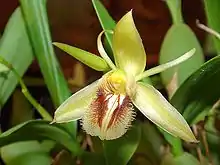| Coelogyne fimbriata | |
|---|---|
 | |
| Scientific classification | |
| Kingdom: | Plantae |
| Clade: | Tracheophytes |
| Clade: | Angiosperms |
| Clade: | Monocots |
| Order: | Asparagales |
| Family: | Orchidaceae |
| Subfamily: | Epidendroideae |
| Tribe: | Arethuseae |
| Genus: | Coelogyne |
| Species: | C. fimbriata |
| Binomial name | |
| Coelogyne fimbriata Lindl. (1825) | |
| Synonyms | |
| |
Coelogyne fimbriata is a species of orchid.
Description
A light loving orchid, it is a small, cool growing epiphyte reaching 40 cm in height with conical, ovoid to pear shaped, longitudinally grooved, 2.5 to 4.0 cm in length and 1.5 to 2.5 cm in width pseudobulbs that are enveloped completely by imbricate, persistent, papery sheaths and carrying 2, oblong-lanceolate, acuminate, lean, 5-15 cm long and 3 cm wide leaves.
Inflorescence
Flowering occurs in summer by means, with spikes protruding from the top of a mature pseudobulb. These carry one to four 4 to 6 cm flowers that open at the same time, last around 7 days, are not very fragrant, have a waxy consistency and are cream colored. The sepals are lanceolate, wider than the petals, which tend to curl backwards. The labellum is hairy and trilobed with raised lateral lobes and has yellow and dark red spots.
Distribution and habitat
It occurs in the Himalayas, Nepal, China, Cambodia, Thailand, Laos, and Myanmar. It grows epiphytic on trees in lower montane forests at an altitude of 900 to 1500 meters above sea level.
Cultivation
They are best grown in pots as hanging plants. In the growing season they need to be watered. These plants should be grown in medium consistency and well drained soil, such as fir bark. They appreciate bright indirect sunlight, from 20 to 40k lux. They grow in a bushy pattern, with many thin aerial roots.